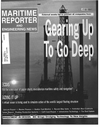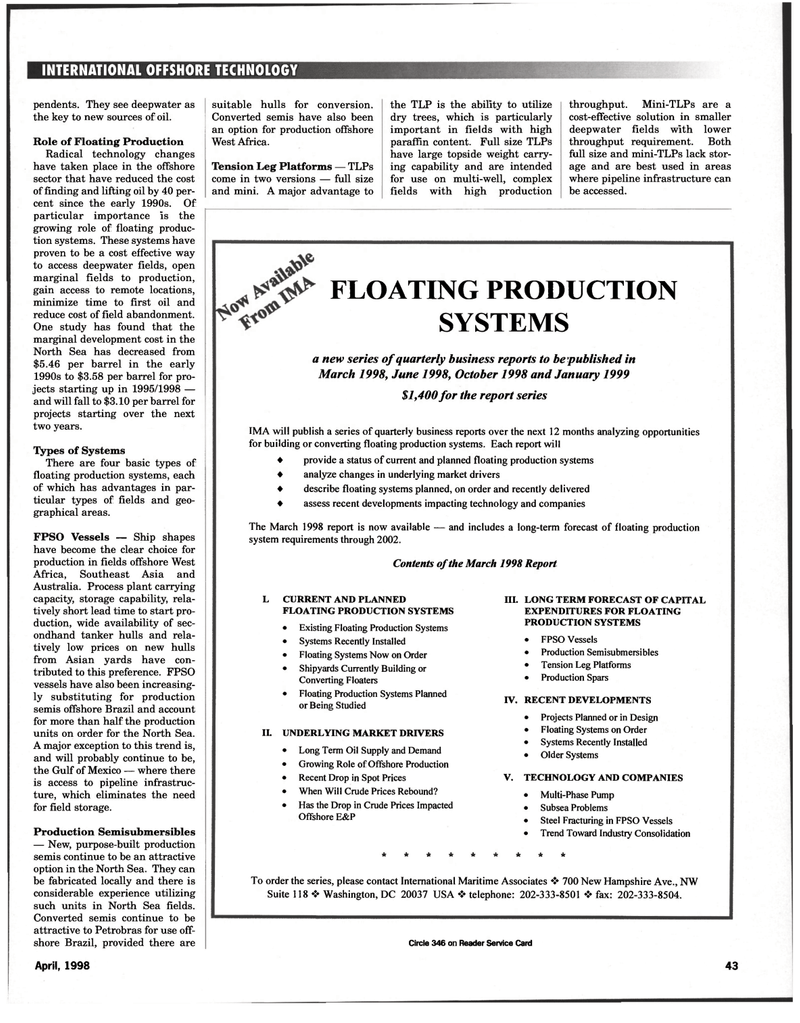
Page 51: of Maritime Reporter Magazine (April 1998)
Read this page in Pdf, Flash or Html5 edition of April 1998 Maritime Reporter Magazine
INTERNATIONAL OFFSHORE TECHNOLOGY pendents. They see deepwater as the key to new sources of oil.
Role of Floating Production
Radical technology changes have taken place in the offshore sector that have reduced the cost of finding and lifting oil by 40 per- cent since the early 1990s. Of particular importance is the growing role of floating produc- tion systems. These systems have proven to be a cost effective way to access deepwater fields, open marginal fields to production, gain access to remote locations, minimize time to first oil and reduce cost of field abandonment.
One study has found that the marginal development cost in the
North Sea has decreased from $5.46 per barrel in the early 1990s to $3.58 per barrel for pro- jects starting up in 1995/1998 — and will fall to $3.10 per barrel for projects starting over the next two years.
Types of Systems
There are four basic types of floating production systems, each of which has advantages in par- ticular types of fields and geo- graphical areas.
FPSO Vessels — Ship shapes have become the clear choice for production in fields offshore West
Africa, Southeast Asia and
Australia. Process plant carrying capacity, storage capability, rela- tively short lead time to start pro- duction, wide availability of sec- ondhand tanker hulls and rela- tively low prices on new hulls from Asian yards have con- tributed to this preference. FPSO vessels have also been increasing- ly substituting for production semis offshore Brazil and account for more than half the production units on order for the North Sea.
A major exception to this trend is, and will probably continue to be, the Gulf of Mexico — where there is access to pipeline infrastruc- ture, which eliminates the need for field storage.
Production Semisubmersibles — New, purpose-built production semis continue to be an attractive option in the North Sea. They can be fabricated locally and there is considerable experience utilizing such units in North Sea fields.
Converted semis continue to be attractive to Petrobras for use off- shore Brazil, provided there are suitable hulls for conversion.
Converted semis have also been an option for production offshore
West Africa.
Tension Leg Platforms — TLPs come in two versions — full size and mini. A major advantage to the TLP is the ability to utilize dry trees, which is particularly important in fields with high paraffin content. Full size TLPs have large topside weight carry- ing capability and are intended for use on multi-well, complex fields with high production
Contents of the March 1998 Report ieie'Je-k-k^e-Jeieie throughput. Mini-TLPs are a cost-effective solution in smaller deepwater fields with lower throughput requirement. Both full size and mini-TLPs lack stor- age and are best used in areas where pipeline infrastructure can be accessed.
L CURRENT AND PLANNED
FLOATING PRODUCTION SYSTEMS • Existing Floating Production Systems • Systems Recently Installed • Floating Systems Now on Order • Shipyards Currently Building or
Converting Floaters • Floating Production Systems Planned or Being Studied
II. UNDERLYING MARKET DRIVERS • Long Term Oil Supply and Demand • Growing Role of Offshore Production • Recent Drop in Spot Prices • When Will Crude Prices Rebound? • Has the Drop in Crude Prices Impacted
Offshore E&P
III. LONG TERM FORECAST OF CAPITAL
EXPENDITURES FOR FLOATING
PRODUCTION SYSTEMS • FPSO Vessels • Production Semisubmersibles • Tension Leg Platforms • Production Spars
IV. RECENT DEVELOPMENTS • Projects Planned or in Design • Floating Systems on Order • Systems Recently Installed • Older Systems
V. TECHNOLOGY AND COMPANIES • Multi-Phase Pump • Subsea Problems • Steel Fracturing in FPSO Vessels • Trend Toward Industry Consolidation
To order the series, please contact International Maritime Associates •> 700 New Hampshire Ave., NW
Suite 118 • Washington, DC 20037 USA • telephone: 202-333-8501 • fax: 202-333-8504.
Circle 346 on Reader Service Card
FLOATING PRODUCTION
SYSTEMS a new series of quarterly business reports to be published in
March 1998, June 1998, October 1998 and January 1999 $1,400for the report series
IMA will publish a series of quarterly business reports over the next 12 months analyzing opportunities for building or converting floating production systems. Each report will • provide a status of current and planned floating production systems • analyze changes in underlying market drivers • describe floating systems planned, on order and recently delivered • assess recent developments impacting technology and companies
The March 1998 report is now available — and includes a long-term forecast of floating production system requirements through 2002.
April, 1998 43

 50
50

 52
52
